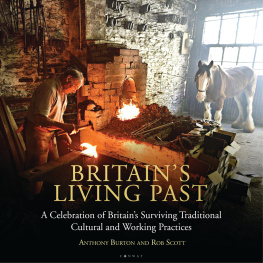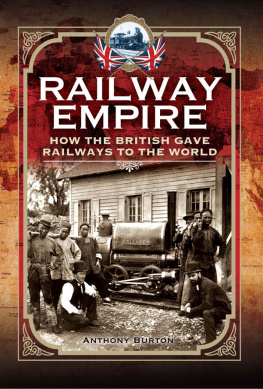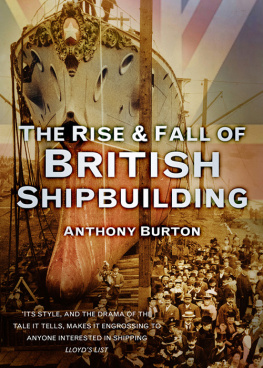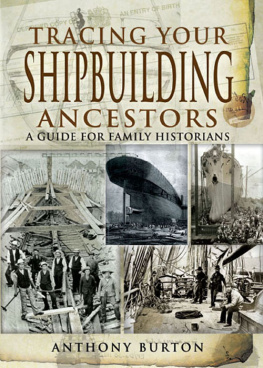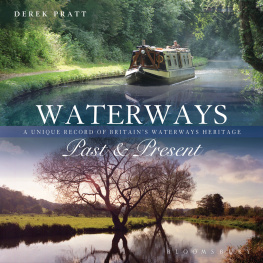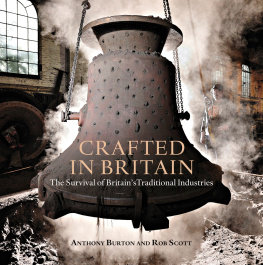CONWAY
Bloomsbury Publishing Plc
50 Bedford Square, London,
WC1B 3DP, UK
This electronic edition published in 2019 by Bloomsbury Publishing Plc
BLOOMSBURY, CONWAY and the Conway logo are trademarks of Bloomsbury Publishing Plc
First published in Great Britain 2019
Copyright Anthony Burton and Rob Scott, 2019
Anthony Burton and Rob Scott have asserted their right under the Copyright, Designs and Patents Act, 1988, to be identified as Authors of this work
All rights reserved
You may not copy, distribute, transmit, reproduce or otherwise make available this publication (or any part of it) in any form, or by any means (including without limitation electronic, digital, optical, mechanical, photocopying, printing, recording or otherwise), without the prior written permission of the publisher. Any person who does any unauthorised act in relation to this publication may be liable to criminal prosecution and civil claims for damages.
Bloomsbury Publishing Plc does not have any control over, or responsibility for, any third-party websites referred to or in this book. All internet addresses given in this book were correct at the time of going to press. The author and publisher regret any inconvenience caused if addresses have changed or sites have ceased to exist, but can accept no responsibility for any such changes
A catalogue record for this book is available from the British Library
Library of Congress Cataloguing-in-Publication data has been applied for
ISBN: 978-1-8448-6544-4 (PB)
ISBN: 978-1-8448-6545-1 (eBook)
ISBN: 978-1-8448-6542-0 (ePDF)
To find out more about our authors and their books please visit www.bloomsbury.com where you will find extracts, author interviews and details of forthcoming events, and to be the first to hear about latest releases and special offers, sign up for our newsletter.

CONTENTS

I NTRODUCTION

There was a time, not so very long ago, when history seemed to consist entirely of kings and queens, famous battles and Acts of Parliament. But there has always been another history, the history of the everyday life of the people, and it can be expressed in many different forms.
There are the industries and crafts that continue to produce all kinds of goods and materials using techniques that, in many cases, have scarcely changed for centuries. At the opposite extreme are the things we do in our spare time, our games and sports and some have survived unchanged for a very long time indeed. It is this sense of continuity that we have tried to capture in the subjects chosen for this book.
The range is wide, and even so the choice has not always been easy. There were far more subjects that could have been included, but we have tried to select ones that each shed a different light on the past as well as those that we both found to be intrinsically interesting. After all, if the writer and photographer are bored, why should you, the reader, have any interest in their book? It has sometimes been a journey of discovery for both of us neither of us, for example, were quite prepared for the mayhem that is the Ashbourne football match. Some subjects were old favourites for one or other of us Anthony has long been an enthusiastic participant in barge matches, while Rob has known Swaledale for many years. But one overriding rule covered everything: for every site or activity we covered, there had to be a real sense that it was still around because it still served a real need or because it was part of a tradition that no one wanted to see simply die away. There had to be a real feeling that what we were seeing was a real, living tradition, continuing to this day because it had an intrinsic value. It is always a thrill to feel that sense of continuity, and we hope that we have managed to recreate something of the same sensation in the following pages.
A MARITIME NATION

THE SHIPWRIGHT

The magnificent covered slipway at Plymouth dockyard, built in 1814.
In this book we are looking at heritage and tradition in many different forms, but there is no tradition that has done more to shape the history of these islands than its long maritime past. This is a heritage that stretches back far beyond written records.
The earliest sailing craft that consisted of anything more than hollowed-out logs were found in the mud of the Humber at North Ferriby, and dating techniques showed them to have been built in around 1500 BC. Over the centuries, vessels were developed and became ever more sophisticated, with the larger ships carrying a vast spread of sail on many masts. These were the vessels that could trade around the world, culminating in the famous fast clipper ships, such as Cutty Sark, that were originally built to bring tea from China. This was a luxury commodity, and the first load to be brought home always fetched the highest price hence the emphasis on speed. But there was also a fascinating array of smaller vessels that never left home waters, trading around the coast. Each region had its own speciality, ranging from the square-rigged Humber keel the nearest thing we now have to a medieval ship to more elaborate topsail schooners. But one thing they all have in common is that they were built out of wood by shipwrights.
In our search for a traditional shipwright still working on wooden boats, one of the criteria we chose was that ideally the work would be done in a building that itself had some historic significance. That requirement was met in a way that hardly seemed possible. Stirling & Son work in what might well be the most historically significant surviving dockyard building in Britain: No. 1 Slip at the former Royal Naval Dockyard at Devonport.
When William of Orange came to the throne as William III, one of his early demands was for a brand-new naval dockyard to be created at Plymouth. Work began in 1690 and the original site eventually became the South Yard, mainly developed in the 18th century. Among the new structures was No. 1 Slip, on which work began in the 1770s. It was here that a number of famous warships were built.
But building in the open air creates difficulties, with work often held up by bad weather. So in 1814 it was roofed over and has remained substantially the same ever since. It is the oldest surviving covered slip of any British naval yard, and as a major historical monument it is a listed building. Its rating is the same as that given to Stonehenge, for example, which gives a good idea of just how important it is. And it is in this building that Will Stirling and his men build and repair wooden vessels of up to 200 tons.
The building looks interesting enough as you get nearer to it, but its only when you step inside that the full majesty of the structure becomes apparent as well as its complexity. The original slip was built up against the tall stone dockyard wall, which now forms one side of the structure. The opposite side of the slipway is a slatted wooden wall that turns inward towards the two ends, which are both entirely open.

